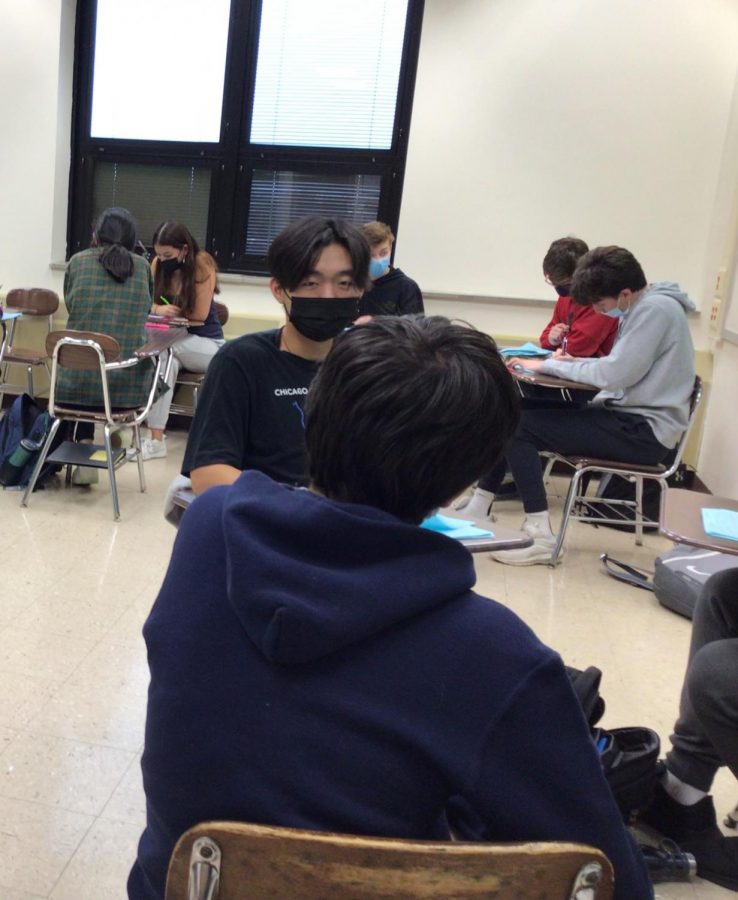Return to full in-person learning: what changed?
Students, teachers compare in-person to pre-covid learning
Zarea
Sophomore Nicholas She works on a math problem with a partner. This year more classes are using small groups to encourage student interaction
Last year, remote and hybrid learning changed the classroom atmosphere and students’ study habits. It created awkward silences in classes, discouraged side conversations, and challenged students’ motivation to complete schoolwork.
With the return to full in- person learning, many things have changed. Students now find it easier to participate in class, complete homework, and stay engaged compared to last year.
“Over remote learning you couldn’t have a side conversation with someone in class and I think it really put a damper on how active you were in class and discussions,” said senior Michelle Lu. “I think just being able to talk to the person next to you makes such a big difference when you’re engaged in class.”
French teacher Amanda Daly notices more chatter in her classes. “This year, especially with my junior classes—which are a bit larger—there’s definitely a lot of chatter and more jovial-ness, which is nice to see because I know that students have been isolated socially for a long time, so I’m happy to see them connect with each other.”
Sophomore Caroline Saunders thinks it is easier to participate now.
“Last year it was a little scary to unmute yourself and actually say something,” she said. “Now, in- person, it just feels a lot more natural just to be able to speak instead of having it being like ‘okay, now I have to unmute myself if I know the answer or have a question.’”
English teacher Eric Stewart noticed that students were more productive when working in groups. “I think that’s because kids so badly missed being able to talk to each other face to face,” he said. “I notice that I am doing less redirecting and just more enjoying and sitting in on the conversations.”
During the remote and hybrid year, students found it harder to do schoolwork because of the change in environment. Teachers found students did not necessarily develop skills needed to succeed after a year of remote/hybrid learning.
Math teacher Shanna Hill said “I think students became much more reliant on resources. While I always spent a lot of time in my sophomore classes talking about student skills—what homework should look like, how to manage your time on tests, how to study—I have found that this year all my students have needed some coaching on this. ”
However, with the return to normalcy, students are adapting to the change.
“While most of them were happy to be back in school, there was a lot of stress and anxiety that came with this transition,” Hill said. “Our students are resilient, though, and after a few weeks of relearning what it means to be a student again, everyone seems to be doing much better!”
Daly said she thinks students handled the transition well, and “that students were handing in their work both during remote and hybrid learning
“I have always had a high rate of homework completion,” she said. Students say they have more motivation because of the separation between school and home. They are finding it easier to focus in-person and are more motivated to do work.
Sophomore Emeric Koller thinks It’s easier to focus in-person. “You’re right there and you can’t just pull out your phone and start playing a game.” Junior Charlotte Calkins feels more motivated when she gets home. “Last year there wasn’t really a separation between schoolwork and homework. I sort of needed to take some kind of break since homework and school work. Personally, I did not like having so many hours of screen time, so I think this year it’s easier for me to get going as soon as I get home rather than needing to take that mental break.”
The last year has also made some teachers more aware of students’ personal situations.
“I think because of teaching hybrid sometimes you would see the chaos going on in somebody’s room or in their living room or in their house, or you would hear yelling and screaming and all kinds of chaos in the background,” Stewart said. “It just is a really good reminder to me as a teacher that even though we’re all sitting in the room and we all appear to be paying attention, that at any given time, somebody might have stuff going on in their lives that’s distracting to them… I think now that I’m back in person I’m really aware of that because I think about the chaotic things that I saw and heard on Zoom.”







































